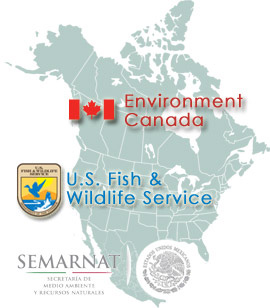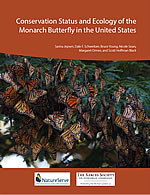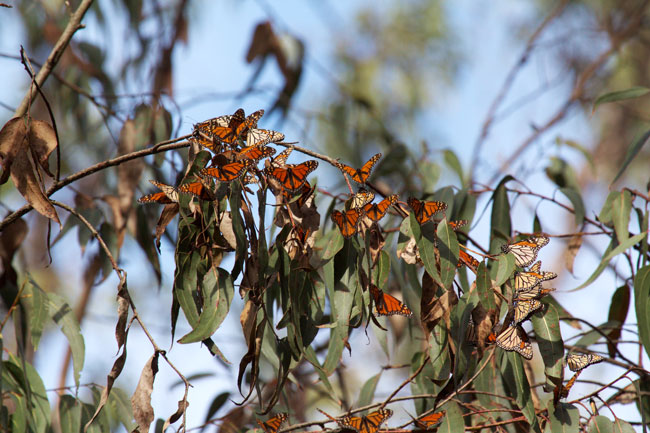Conservation in North America
 Participants of the Monarch Flyway Conservation Workshop, Mission Texas, December 2006. Photo by Carol Lively.
Participants of the Monarch Flyway Conservation Workshop, Mission Texas, December 2006. Photo by Carol Lively.
The persistence of the monarch butterfly’s spectacular and unique migratory phenomenon is dependent on the conservation of habitats in Canada, the United States, and Mexico. No species better symbolizes the ecological links among the three countries.
Many government agencies, organizations, and individuals across North America are working on projects to conserve monarch habitats and the migration phenomenon.
- Monarch Butterfly Monitoring in North America: Overview of Initiatives and Protocols (February 2009) (PDF, 4.3 MB)
Monarch Joint Venture Accomplishments
The Monarch Joint Venture (MJV) is a partnership of federal and state agencies, non-governmental organizations, and academic programs working together to support and coordinate efforts to protect the monarch migration across the lower 48 United States. Read more about the Forest Service's accomplishments as a partner with the Monarch Joint Venture to support monarch habitat conservation, maintenance and enhancement; education; and research and monitoring.
Protecting Mexico’s Forests
Mariposa Monarca Biosphere Reserve
The high altitude forests that provide winter habitat for hundreds of millions of monarch butterflies are on the borders of the states of Mexico and Michoacan. In 1986, the Mexican government created the Monarch Butterfly Biosphere Reserve (Mariposa Monarca Biosphere Reserve) to protect 62-square miles of forests within four separate monarch sanctuaries. The Biosphere Reserve was expanded to include 217 square miles in 2000.
The Monarch Butterfly Biosphere Reserve is a part of Mexico’s federal system of protected areas. The National Commission of Natural Protected Areas (Comision Nacional de Areas Naturales Protegidas) (in Spanish) administers the federal protected areas in Mexico.
Working with Local Communities
Much of the land within the Monarch Butterfly Biosphere Reserve is communally owned “ejido” land. The residents of the ejidos are poor farmers who have relied on these forests for lumbering, firewood, and construction material for generations.
Although logging was outlawed in the core zone when the Monarch Butterfly Biosphere Reserve was created in 1986, illegal logging remains a problem today. Deforestation threatens the wintering habitat of the monarch butterfly.
A number of organizations are working to promote sustainable forestry practices, forest conservation and reforestation, and help residents to find alternative ways to supplement their incomes.
- Forests for Monarchs is a project of La Cruz Habitat Protection Project, Inc., a U.S. non-profit organization, in partnership with La Cruz Habitat Protection Project – Mexico in support of the planting and management of sustainable new forests in Michoacan, Mexico and beyond.
- Alternare (in Spanish), a nonprofit organization founded in 1998, works to help local residents find sustainable, income-producing alternatives to logging in the Monarch Butterfly Biosphere Reserve.
U.S. Fish and Wildlife Service (USFWS) - Wildlife Without Borders - Mexico Program
Since 1995, the USFWS Wildlife Without Borders - Mexico grants program, in partnership with Mexican authorities and non-governmental organizations, has invested over $700,000 in projects to protect and restore the wintering habitat of the monarch butterfly. For example, the Service partners with Mexican authorities and ALTERNARE, A.C. to support a training program to develop the natural resource management capabilities of local communities. Training has included soil and water conservation, use of organic fertilizer to increase crop production, income generating activities such as bee keeping, and construction of solar powered cooking boxes and adobe houses to reduce the need for firewood. The Service has also funded programs to provide training in reforestation techniques for peasant farmers living in the Reserve.
U.S. Forest Service International Programs
Since 1993, the U.S. Forest Service International Programs has been working with Monarch Butterfly Biosphere Reserve managers and partners in the region to build management capacity, to provide guidance to communities for resource management, and to conserve natural resources in the core zone of the Reserve. Staff from the Willamette National Forest and other units has provided training and consultations to the Reserve on forest inventory, GPS/GIS utilization, and design and maintenance of trails. Through a partnership with the Monarch Model Forest, partners developed proposals to help the Model Forest with recreation management, landscape ecology, small-scale wood product development and marketing, and community incentive programs. Working with local communities adjacent to the Monarch Butterfly sanctuaries, project participants worked to reforest lands using native tree species-with the long-term goal of establishing alternative sites for extracting wood. Apart from reforestation, the Model Forest and its partners have worked on recreation and eco-tourism.
A Continental Approach
North American Monarch Conservation Plan
Canada, Mexico, and the United States have joined to produce the North American Monarch Conservation Plan (NAMCP), a long-term cooperative agenda to conserve the monarch butterfly and its unique migratory phenomenon. Because the monarch and its migration depend on conservation of habitats in all three countries, this species has become a symbol of our shared environment.
Read more about the North American Monarch Conservation Plan…
Trilateral Monarch Butterfly Sister Protected Area Network
The Trilateral Monarch Butterfly Sister Protected Area (SPA) Network is a partnership of wildlife refuges and national parks in the United States and Canada, and natural protected areas in Mexico working together on monarch conservation projects. The SPA network is a project of the Trilateral Committee for Wildlife and Ecosystem Conservation and Management. The Trilateral Committee is headed by the directors of the Canadian Wildlife Service (CWS), the U.S. Fish and Wildlife Service (USFWS), and the Ministry of Environment and Natural Resources of Mexico (SEMARNAT). The project was initiated in May 2006 to collaborate on monarch habitat preservation and restoration; research and monitoring; and environmental education and public outreach. See a listing of the 13 protected areas…
Protection Efforts in Canada
The monarch butterfly is listed as a species of special concern and protected under Canada’s federal Species at Risk Act. More information about the status of the monarch and efforts at protection in Canada is available at the Government of Canada Species at Risk - Species Profile - Monarch.
Conservation Status and Ecology of the Monarch Butterfly in the United States
Prepared by NatureServe and The Xerxes Society for Invertebrate Conservation for the Forest Service, the report, Conservation Status and Ecology of the Monarch Butterfly in the United States (PDF, 10.2 MB), summarizes the monarch butterfly’s North American distribution, life history, population, current conservation status, and potential causes of decline. In addition, there is a set of breeding and overwintering habitat management recommendations. This report aims to inform government agencies charged with biodiversity protection, as well as conservation organizations and the public in general about the threats to and current conservation status of this much-loved, iconic insect.
Conservation and Management of Monarch Butterflies: A Strategic Framework
The USDA Forest Service Conservation and Management of Monarch Butterflies: A Strategic Framework (PDF, 8.8 MB) will guide the Forest Service to effectively and efficiently use available resources and engage public and private partnerships in taking action for the conservation of the monarch butterfly.
New Guidelines for Protecting California’s Butterfly Groves
To guide land managers, landowners, and community groups who wish to implement management actions to protect, improve, and restore monarch overwintering habitat, the Xerces Society partnered with Stu Weiss of Creekside Center for Earth Observation to publish Protecting California’s Butterfly Groves: Management Guidelines for Monarch Butterfly Overwintering Habitat.







